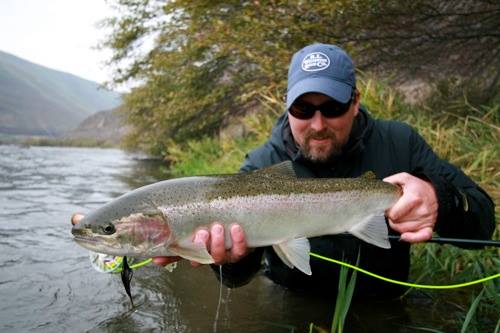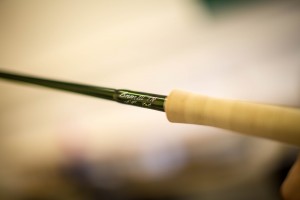Q: You’re well known as a two-handed specialist. What is it about that particular discipline of fly fishing that attracted you?
TL: I was first drawn to Spey fishing when I lived and guided in the Great Lakes region, back in the mid-nineties. Swinging a fly with a two-hander just had a feel that was unmistakably soulful. Ultimately, two-handed fishing is what made me move to the Deschutes. I wanted to immerse myself in the sport on a river that screams for Spey rods.
From a fishing perspective the benefits of a long rod are huge. You can cover endless water, make long casts in the tightest of spots and most importantly, you have total control of your presentation. Plus, Spey casting is really fun! Nothing in our sport measures up to uncorking a long, perfect Spey cast and hooking a raging steelhead. (Well… Tarpon are right up there)
For the record, while swinging flies and casting Spey rods is my biggest passion, I love every texture of the sport. Every spring I turn into a total trout nut. My steelhead friends don’t get it. But chasing hatches and rising trout drives me as a guide and angler. Furthermore, growing up in Wisconsin, smallmouth fishing is in my blood. It should also be noted that I’ve threatened more than once to move to a place where the water is salt, the beaches are white and you fish from a flats skiff! At the end of the day, I love fishing for just about anything.
Q: What are some of the innovations that are coming out of the two-handed community? Any new techniques or perspectives emerging?
TL: When I started designing Spey lines about ten years ago, I had one simple mission – make Spey equipment that the average angler could have fun with. At the time, most of the two-handed fly lines where designed by expert casters for expert casters. Back then, teaching a new fly fisherman Spey casting was paramount to putting 210 cm giant slalom skis on a beginner skier. Today’s Spey lines have done to two-handed fishing what shaped skis did for skiing. –They’ve made casting way easier to learn. More importantly, modern Spey lines are more effective fishing tools then fly lines of the past.
The new lines have also caused a revolution in Spey rods. The days of swinging a fourteen foot #9 weight are over for most of us. Today’s fly lines allow us to fish smaller, lighter rods than ever. In my mind, lighter gear equates to more fun. I pretty much fished the new 12’6 #6 weight Boron III TH exclusively last fall. That size rod was once thought of as only a dry line stick. With today’s lines I can throw any sink-tip I need to for my summer steelhead rivers. The rod is so light in hand I can fish it all day without wearing out. I love it!
Spey fishing is indeed heading in a new direction… Anglers around the world are seeing the benefits of two-handers for many species outside of the anadromous realm. Beach anglers are gravitating towards switch rods for over-head casting shooting heads. My buddies in the Midwest are chasing smallies with them. I even know some pike & musky guys that are throwing two-handers. However, trout fishing with Spey rods is without a doubt the biggest emerging technique.
For the wading trout angler, two-handers are amazing tools for fishing streamers, swinging caddis pupas, or fishing traditional wet flies. More so, indicator fishing with large heavy nymphs is a dream with the longer sticks. I’m not saying I’m selling my 9’ #5 weight… Two-handers are just another tool that can be used for specific trout fishing situations.
There’s also something to be said about catching fish the way you want to catch them, not necessarily because it’s the most effective method. A lot of trout guys I know are choosing to cast with two hands for no other reason than it’s really fun.
Q: You’ve written a lot about the history of the fisheries that you know best — environment, local pressures, flora and fauna. How does that understanding deepen your experiences on the water — as a guide or as an enthusiast?
TL: One of the best elements of guiding is becoming completely “In tune” with the river, the fish and the environment you work in.
I’ve always strived to be a good observer when fishing and guiding. In my mind, if I know my river intimately I can recognize when something changes. It’s extremely gratifying when I sense change and can adjust my game plan accordingly. Sometimes those changes are incredibly subtle like a trout changing its rise form as it switches from eating emergers to duns. Other times the change can smack you in the face -like your river blowing out. In the end, the most successful anglers I know always slow down and watch their river. They observe, listen and learn as much as possible.
Q: As new generations of anglers are introduced to the sport, how do you think things will change over the next five years?
TL: I see a couple of great changes in the future of fly fishing. First, the number of women getting into our sport is fantastic. I expect that growth to continue. More and more women are realizing that fly fishing is “Life Sport” and that gender has no advantage. That’s pretty cool. Secondly, I see more folks getting involved with fisheries conservation. People are realizing that our rivers need more friends. Also a really good thing.
On a negative note, over the past 18 years of guiding I’ve noticed that river etiquette has gone to hell in a hand basket. Unfortunately, I only see it getting worse. As the world grows, our sense of space is being eroded. Some people seem very comfortable fishing very close to others. There used to be a code on the water… I want it back.
Q: You’ve called the Deschutes “a proving ground for an angler’s skill”. What is it about this river that makes — or breaks — so many anglers?
TL: The biggest challenge of the Deschutes is it’s difficult wading. That, coupled with the fact that by law you can’t fish from a boat separates the “D” from most rivers.
From a trout fishing perspective, it’s not a river you can just float down in a drift boat; throw an indy rig and rail on fish. You have to wade into position and make the cast. Plus, Deschutes rainbows are all wild and very aware of their predators. Consequently, they don’t tolerate sloppy presentation. Given the big pushy nature of the river and the inevitable afternoon winds during the summer months, fishing with precision isn’t always easy. That being said, the Deschutes is a place where strong casting, good presentation and a little bit of old fashion effort are rewarded in spades. The trout are amazing.
From a steelheader’s point of view, while the wading is rugged, the lack of boat anglers is pure joy. Few steelhead rivers in the world afford this luxury. It should also be noted that not every steelhead run is hard wading. I once guided a 91-year-old man on the river -he landed three that day! Most people do just fine if they come prepared with felt studded boots and a wading staff.
The diversity of great steelhead water on the Deschutes is amazing. You can fish some big, lazy runs with pretty mellow wading, casting and fishing conditions. On the other, if you like fishing gnarly ledge water that challenges you on every step, every cast, every swing… The Deschutes has that too. –The river is a playground for steelheaders of any ability level.




